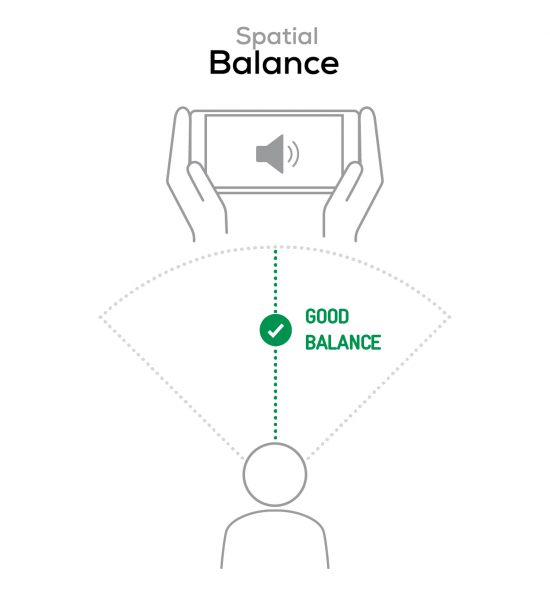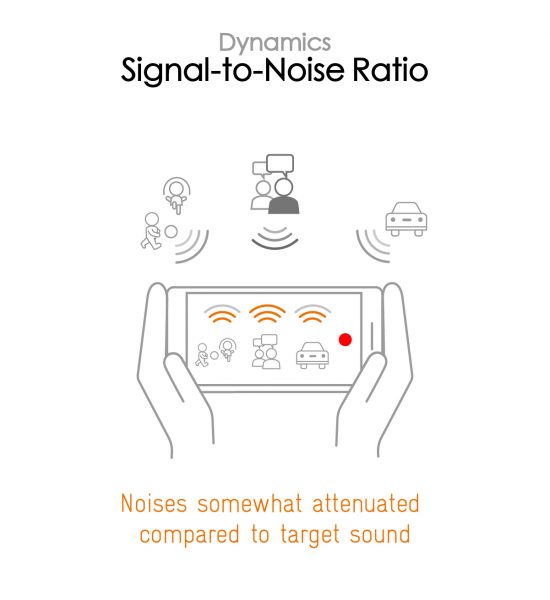We put the Google Pixel 6a through our rigorous DXOMARK Audio test suite to measure its performance both at recording sound using its built-in microphones, and at playing audio back through its speakers.
In this review, we will break down how it fared in a variety of tests and several common use cases.
Overview
Key audio specifications include:
- Two speakers (top center – bottom right)
- No jack audio output
Scoring
Sub-scores and attributes included in the calculations of the global score.
Google Pixel 6a


 46th
46th 4th
4thPlayback
Pros
- Good dynamics performance across all volume levels
- Good distance rendering and localizability
- No speaker occlusion with natural hand position
- Audio artifacts well under control
Cons
- Slightly thin tonal balance, midrange-focused, lack of low-end extension
- Narrow sound scene
Recording
Pros
- Good tonal balance; emphasis on lower spectrum results in better concert recording than Pixel 6
- Good dynamics performance
- Wide recorded sound scene in video
Cons
- Narrow sound scene with selfie video
- Extra bass (compared with Pixel 6) results in some bass distortions
In our DXOMARK Audio testing, the Google Pixel 6a delivered an excellent performance for a device in its class. Overall, audio results were very similar to the standard Pixel 6, with only some minor differences between the two models. As a playback device, the Pixel 6a was most suitable for movie watching and listening to music, thanks to a good dynamics performance, distance perception, and localizability of individual sound sources. In addition, when holding the phone normally, it was pretty much impossible to involuntarily cover the speakers. However, our testers found the tonal balance to lack bass and the sound scene to be more narrow than expected for a device of the Pixel’s dimensions.
The recording performance was just as good as playback. The Google device was most suitable for main camera recording, closely followed by front camera video recording. Audio recordings featured a good tonal balance, with more low-end extension than the standard Pixel 6, good dynamics, and when recording with the main camera, good wideness. The latter was more limited with the selfie camera, though, and the stronger focus on bass also resulted in more distortion.
Test summary
About DXOMARK Audio tests: For scoring and analysis in our smartphone audio reviews, DXOMARK engineers perform a variety of objective tests and undertake more than 20 hours of perceptual evaluation under controlled lab conditions.
(For more details about our Playback protocol, click here; for more details about our Recording protocol, click here.)
The following section gathers key elements of our exhaustive tests and analyses performed in DXOMARK laboratories. Detailed performance evaluations under the form of reports are available upon request. Do not hesitate to contact us.
Playback
Google Pixel 6a
163
DXOMARK engineers test playback through the smartphone speakers, whose performance is evaluated in our labs and in real-life conditions, using default apps and settings.
In playback, the Pixel 6a sounded a little thin and midrange-focused, lacking both low and high-end extension, but it was still an improvement over the Pixel 6. Dynamics performance was average for this class of device, with a consistent punch. Attack could have been sharper but remained relatively consistent across volume levels. Bass precision was an improvement over the standard Pixel 6 and remained consistent at both extremes of the volume scale.
The sound scene created by the speakers was slightly narrower than we would have expected from a device with the Pixel 6a’s dimensions, but individual instruments and voices were very easy to locate within the scene. Distance rendering was very good, but our testers noted that the left/right channels of the stereo did not follow device rotation when playing games.
The device delivered good loudness at maximum volume, and the lowest audio setting was nicely tuned and intelligible. In terms of audio artifacts, some slight pumping was noticeable at maximum volume and our testers also noticed some slight static noise on some occasions.
Listen to the tested smartphone’s playback performance in this comparison with some of its competitors:

Timbre
Google Pixel 6a
158
The Timbre score represents how well a phone reproduces sound across the audible tonal range and takes into account bass, midrange, treble, tonal balance, and volume dependency. It is the most important attribute for playback.

Dynamics
Google Pixel 6a
149
The Dynamics score measures the accuracy of changes in the energy level of sound sources, for example how precisely a bass note is reproduced or the impact sound from drums.



Spatial
Google Pixel 6a
162
The sub-attributes for spatial tests include pinpointing a specific sound's location, its positional balance, distance, and wideness.



Volume
Google Pixel 6a
162
The Volume score represents the overall loudness of a smartphone and how smoothly volume increases and decreases based on user input.
| Hip-Hop | Classical | |
| Google Pixel 6a | 74.1 dBA | 69.1 dBA |
| Google Pixel 6 | 74.9 dBA | 69.6 dBA |
| Xiaomi 12T | 74.8 dBA | 69.4 dBA |

Artifacts
Google Pixel 6a
157
The Artifacts score measures the extent to which the sound is affected by various types of distortion. The higher the score, the less the disturbances in the sound are noticeable. Distortion can occur because of sound processing in the device and because of the quality of the speakers.


It represents the distortion and noise of the device playing our test signal (0 dB Fs, Sweep Sine in an anechoic box at 40 cm) at the device's maximum volume.
Recording
Google Pixel 6a
160
DXOMARK engineers test recording by evaluating the recorded files on reference audio equipment. Those recordings are done in our labs and in real-life conditions, using default apps and settings.
When recording video with the main camera, the recorded sound scene was wide, but with slightly imprecise localizability of individual sound sources. Distance rendition was good. The wideness of the audio scene was more limited when shooting selfie video in portrait orientation. Voices remained well-centered, though, and localizability was better than for the main camera video.
Recording loudness was very good. In fact, the Pixel 6a was the best Pixel device in this respect that we have seen to date. Artifacts were well under control as well, with only some slight clipping on louder content and some distortion with loud bass. Background rendition on main camera recordings was clean but came with a slightly nasal tonal balance and, despite the overall extra bass, it sounded quite thin. The tonal balance was more natural in front camera recordings.
Here is how the Google Pixel 6a performs in recording use cases compared to its competitors:

Timbre
Google Pixel 6a
147
The Timbre score represents how well a phone captures sounds across the audible tonal range and takes into account bass, midrange, treble, and tonal balance. It is the most important attribute for recording.

Dynamics
Google Pixel 6a
146
The Dynamics score measures the accuracy of changes in the energy level of sound sources, for example how precisely a voice's plosives (the p's, t's and k's, for example) are reproduced. The score also considers the Signal-to-Noise Ratio (SNR), for example how loud the main voice is compared to the background noise.



Spatial
Google Pixel 6a
159
The sub-attributes for spatial tests include pinpointing a specific sound's location, its positional balance, distance, and wideness on the recorded audio files.



Volume
Google Pixel 6a
170
The Volume score represents how loud audio is normalized on the recorded files and the how the device handles loud environments, such as electronic concerts, when recording.
| Meeting | Life Video | Selfie Video | Memo | |
| Google Pixel 6a | -27.6 LUFS | -19.3 LUFS | -17.8 LUFS | -20.9 LUFS |
| Google Pixel 6 | -27.8 LUFS | -17.9 LUFS | -16.3 LUFS | -19.8 LUFS |
| Xiaomi 12T | -27.9 LUFS | -21.3 LUFS | -19.5 LUFS | -21.4 LUFS |
The Artifacts score measures the extent to which the recorded sounds are affected by various types of distortions. The higher the score, the less the disturbances in the sound are noticeable. Distortions can occur because of sound processing in the device and the quality of the microphones, as well as user handling, such as how the phone is held.


In this audio comparison, you can listen to the way this smartphone handles wind noise relative to its competitors:

Background
Google Pixel 6a
166
Background evaluates how natural the various sounds around a voice blend into the video recording file. For example, when recording a speech at an event, the background should not interfere with the main voice, yet it should provide some context of the surroundings.





DXOMARK encourages its readers to share comments on the articles. To read or post comments, Disqus cookies are required. Change your Cookies Preferences and read more about our Comment Policy.